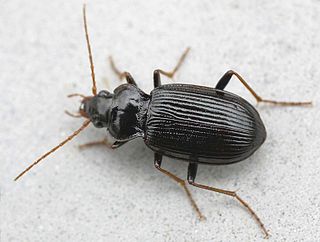
The peppered moth is a temperate species of night-flying moth. Peppered moth evolution ism an example of population genetics and natural selection.
The Carbonária was originally an anti-clerical, revolutionary, conspiratorial society, originally established in Portugal in 1822 and soon disbanded. It was allied with the Italian Carbonari. A new organization of the same name and claiming to be its continuation was founded in 1896 by Artur Augusto Duarte da Luz de Almeida. This organization agitated against the monarchy and was involved in various anti-monarchist conspiracies. Its operational units, structured into a hierarchy of barracas, choças and vendas, received military training.
The Rio Branco antbird is a bird species in the family Thamnophilidae. It is found in Brazil (Roraima) and Guyana. Its natural habitats are subtropical or tropical moist lowland forests and subtropical or tropical moist shrubland. It is severely threatened by habitat loss.

The grey-bellied flowerpiercer is a species of bird in the family Thraupidae. It is found in the Bolivian Andes and far northwestern Argentina.

The yellow-footed tortoise, also known as the Brazilian giant tortoise, commonly referred to as the Brazilian giant turtle, or more commonly, the big turtle, is a species of tortoise in the family Testudinidae and is closely related to the red-footed tortoise. It is found in the Amazon Basin of South America.

Silva Carbonaria, the "charcoal forest", was the dense old-growth forest of beech and oak that formed a natural boundary during the Late Iron Age through Roman times into the Early Middle Ages across what is now western Wallonia. The Silva Carbonaria was a vast forest that stretched from the rivers Zenne and the Dijle in the north to the Sambre in the south. Its northern outliers reached the then marshy site of modern Brussels.

Geopyxis carbonaria is a species of fungus in the genus Geopyxis, family Pyronemataceae. First described to science in 1805, and given its current name in 1889, the species is commonly known as the charcoal loving elf-cup, dwarf acorn cup, stalked bonfire cup, or pixie cup. The small, goblet-shaped fruitbodies of the fungus are reddish-brown with a whitish fringe and measure up to 2 cm (0.8 in) across. They have a short, tapered stalk. Fruitbodies are commonly found on soil where brush has recently been burned, sometimes in great numbers. The fungus is distributed throughout many temperate regions of the Northern Hemisphere. It is found in Europe, Turkey, and North America. Although it is primarily a saprotrophic species, feeding on the decomposing organic matter remaining after a fire, it also forms biotrophic associations with the roots of Norway spruce.

Nebria is a genus of ground beetles native to the Palearctic, the Near East and North Africa.

Nebria brevicollis is a species of ground beetle native to Europe and the Near East. In Europe, it is found in all countries and islands except the Azores, the Canary Islands, the Channel Islands, Franz Josef Land, Gibraltar, Madeira, Malta, Monaco, the North Aegean Islands, Novaya Zemlya, San Marino, the Selvagens Islands, Svalbard and Jan Mayen, and Vatican City. It has now been reported as introduced in western Oregon, U.S.A., where it has been found in highly disturbed sites as well as in native old-growth forest stands. It has also now been found in Washington State.

Nebria livida is a species of ground beetle with two subspecies:

Tetragonula carbonaria is a stingless bee, endemic to the north-east coast of Australia. Its common name is sugarbag bee. They are also occasionally referred to as bush bees. The bee is known to pollinate orchid species, such as Dendrobium lichenastrum, D. toressae, and D. speciosum. It has been identified as an insect that collects pollen from the cycad Cycas media. They are also known for their small body size, reduced wing venation, and highly developed social structure comparable to honey bees.
Nebria aetolica is a species of ground beetle in the Nebriinae subfamily that can be found in Albania, Greece, and North Macedonia.
Nebria rubripes is a species of ground beetle in the Nebriinae subfamily that can be found in France and Spain.
Nebria tatrica is a species of ground beetle in the Nebriinae subfamily that can be found in Poland Czech Republic and Slovakia.
Nebria laticollis is a species of ground beetle in the Nebriinae subfamily that can be found in France, Italy, and Switzerland.
Nebria cordicollis is a species of black coloured ground beetle from Nebriinae subfamily that can be found in Italy and Switzerland. The species is 5 millimetres (0.20 in) long.
Events in the year 1822 in Portugal.











